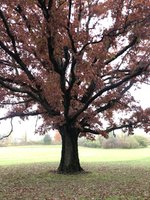@Brad in GR
Combine the 3 answers from
@leatherback ,
@Dav4 ,
@Bnana and the factual observation from
@PA_Penjing and you have a nearly complete explanation of longevity in trees.
Trees have no fixed life spans.
Most of the tables that list longevity, the longevity is listed relevant to a PURPOSE. In other words, the tree does not drop dead at a date certain, the tables usually mean that for a given purpose the tree is unlikely to serve its function after a certain age.
For example, red oak, Quercus rubra in a forestry text might be listed as having a lifespan of 75 years. But you need to read how the forestry text is using lifespan. In the case of timber management, it is the point in time that an entire STAND of trees, a certain percentage will have begun to develop heartwood rots. I believe the number to be 25% but its been a while since I read a forestry text. So in other words, if you plan on harvesting the stand of red oaks, do it before 75 years, because after 75 years on the average your board feet yield of dimensional lumber will begin to decline.
Landscape architecture texts will say a tree like Amur maple has a longevity of 60 years, or a Albizia might have a span of 30 years. This is the time the tree can be expected to "look attractive" and remain in its space allotted. After that period, one can expect mechanical damage and disease issues will have accumulated to the point that the tree is no longer attractive. Not dead. Just no longer attractive for the purpose of landscape architecture.




